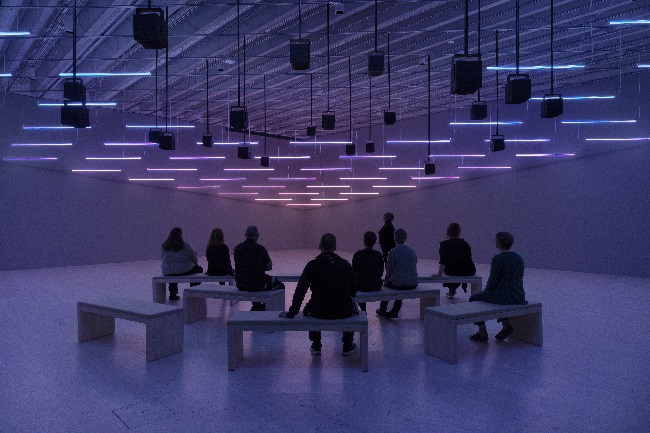UofG Curator Sarah Cook Collaborates on AI-Inspired Art Exhibition Machine Auguries
Published: 16 January 2025
A new site-specific edition of Machine Auguries, a groundbreaking AI artwork, is now on show at Bildmuseet in Umeå, Sweden, with collaboration from the University of Glasgow's Professor Sarah Cook, a leading curator of media and digital art.

A new site-specific edition of Machine Auguries, a groundbreaking AI artwork by London-based artist Alexandra Daisy Ginsberg, is now on show at Bildmuseet in Umeå, Sweden, with collaboration from the University of Glasgow's Professor Sarah Cook, a leading curator of media and digital art.
Ginsberg’s immersive sound and light installation explores humanity’s relationship with nature and technology, using AI-generated birdsong to reflect on and warn about the decline of bird populations due to human activity.
The solo presentation, which opened in October and runs until April 2025, uses a type of neural network called a Generative Adversarial Network (GAN) to recreate the dawn chorus. The GAN, trained on tens of thousands of field recordings of different bird species, produces increasingly lifelike synthetic birdsong, raising thought-provoking questions about authenticity and the consequences of trying to engineer nature using technological systems.
Professor Cook’s curatorial involvement in the presentation of Machine Auguries at Bildmuseet highlights the University of Glasgow’s engagement with cutting-edge discussions in media arts and environmental sustainability.
Professor Cook, a Professor in Museum Studies at the Univerity’s College of Arts & Humanities said: “I am thrilled that people can experience Machine Auguries installed so beautifully at one of Sweden’s most important contemporary art museums.
“I co-commissioned the first edition of the work in London in 2019, and it is a work of art which feels more urgent each time it is shown. As AI technologies become increasingly inescapable and the natural world ever more threatened, Daisy’s artwork asks viewers to stop and think; as she says, once nature is gone we can’t replace it. Machine Auguries is a deliberately fake experience of nature, a simulation, so you question what is real, and what is worth saving?”
This is the first time that three choruses of Machine Auguries—London (2019), Toledo, Ohio (2023), and Umeå (2024)—are being shown together. The Umeå-specific dawn chorus was added to the exhibition on 12 January 2025.
The exhibition programme to date has included Bildmuseet's ‘Art Friday’ featuring a conversation between Ginsberg and Professor Cook. Forthcoming events include talks by Umeå University-based researchers in Arctic studies, ornithology, chronobiology, and art
Recently Professor Cook gave a keynote lecture about AI and Art to the Swedish Research Council's annual symposium on artistic research. Machine Auguries is part of a wider research programme at Bildmuseet, which includes another forthcoming exhibition to be curated by Professor Cook exploring AI’s impact on society.
The exhibition is supported by Kempestiftelserna, the Arctic Centre at Umeå University, UmArts and WASP-HS. For more details, visit the Bildmuseet website.
The Artist
Alexandra Daisy Ginsberg (b. 1982) is a multidisciplinary artist based in London, examining humans’ fraught relationship with nature and technology. Her work has been shown worldwide, including at MoMA, New York; the Museum of Contemporary Art, Tokyo; the Centre Pompidou, Paris; and the Royal Academy, London. She has a PhD from the Royal College of Art. In 2023, she won the S+T+ARTS Grand Prize – Artistic Exploration from the European Commission for her interspecies living artwork Pollinator Pathmaker. This is the artist’s first solo presentation in Sweden. Special thanks to the Cornell Lab of Ornithology | Macaulay Library for their support of this artwork.
Professor Sarah Cook
Sarah Cook is Professor of Museum Studies in Information Studies at the University of Glasgow as well as UmArts WASP-HS Guest Professor at Bildmuseet and Umeå School of Architecture, supported by the Wallenberg AI, Autonomous Systems and Software Program – Humanities and Society (WASP-HS).
First published: 16 January 2025

